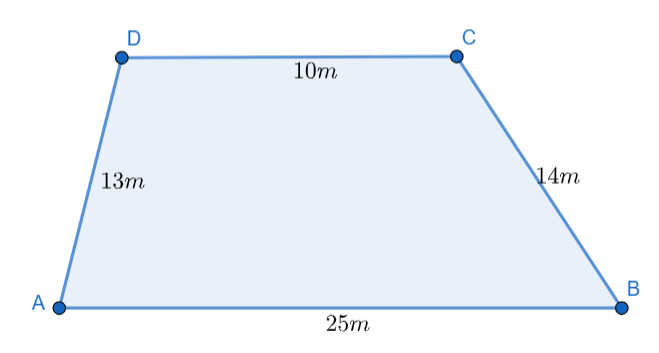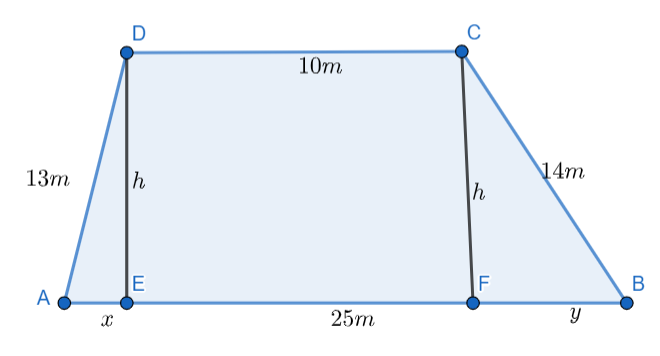
Answer
497.7k+ views
Hint: The given question is related to the area of a trapezium. To find the distance between parallel sides, draw perpendiculars from the vertices to the opposite parallel side and use Pythagoras theorem in the triangles formed.
Complete step-by-step answer:
Consider the trapezium $ABCD$ with $AB\parallel CD$. The lengths of the parallel sides are given as $25\,m$ and $10\,m$. So, $AB=25\,m$ and $CD=10\,m$. The lengths of the non-parallel sides are given as $14\,m$ and $13\,m$. So, $AD=13\,m$ and $BC=14\,m$.

We are asked to find the area of this trapezium. We know, if $a$ and $b$ are the lengths of the parallel sides and $h$ is the distance between the parallel sides of a trapezium, then its area is given as $Area=\dfrac{1}{2}\left( a+b \right)h$. In the given problem, we know the lengths of the parallel sides but we do not know the distance between the parallel sides.
Let’s draw two perpendiculars on the side $AB$, one from the vertex $D$ and the other from the vertex $C$. Let these perpendiculars be $DE$ and $CF$ respectively. We know the distance between the parallel sides is the length of the perpendicular line between them. So, $DE=CF=h$, where $h$ is the distance between the parallel sides of the trapezium.

Let $AE=x\,m$ and $FB=y\,m$. $DE$ and $CF$ are two perpendiculars between two parallel lines. So, they must be parallel to each other. So, the distance between them should be constant. So, $EF=CD=10\,m$. So, $x+y+10=25$.
$\Rightarrow x+y=15.....(i)$
Now, in $\Delta AED$ , $DE\bot AE$. So, $\Delta AED$ is a right-angled triangle. Applying Pythagoras theorem, we get ${{x}^{^{2}}}+{{h}^{2}}={{13}^{2}}$.
$\Rightarrow {{x}^{2}}+{{h}^{2}}=169.....(ii)$
In $\Delta CBF$ , $CF\bot BF$. So, $\Delta CBF$ is a right-angled triangle. Applying the Pythagoras theorem, we get ${{y}^{2}}+{{h}^{2}}={{14}^{2}}$.
$\Rightarrow {{y}^{2}}+{{h}^{2}}=196.....(iii)$
Now, from equation $(i)$, we have $x+y=15$. $\Rightarrow x=15-y$
Substituting $x=15-y$ in equation $(ii)$, we get ${{\left( 15-y \right)}^{2}}+{{h}^{2}}=169$.
$\Rightarrow 225+{{y}^{2}}-30y+{{h}^{2}}=169$
$\Rightarrow {{y}^{2}}-30y+{{h}^{2}}=169-225$
$\Rightarrow {{y}^{2}}-30y+{{h}^{2}}=-56$
$\Rightarrow {{h}^{2}}=30y-{{y}^{2}}-56$
Substituting ${{h}^{2}}=30y-{{y}^{2}}-56$ in equation $(iii)$, we get ${{y}^{2}}+30y-{{y}^{2}}-56=196$
$\Rightarrow 30y=252$
$\Rightarrow y=8.4$
Now, substituting $y=8.4$ in ${{h}^{2}}=30y-{{y}^{2}}-56$, we get ${{h}^{2}}=30\left( 8.4 \right)-{{\left( 8.4 \right)}^{2}}-56$.
$\Rightarrow {{h}^{2}}=252-70.56-56$
$\Rightarrow {{h}^{2}}=125.44$
$\Rightarrow h=11.2$
So, the distance between the parallel sides is $11.2\,m$.
Now, we have the values of the lengths of parallel sides as well as the distance between the parallel sides.
So, the area of the trapezium is given as $Area=\dfrac{1}{2}\left( 10+25 \right)\times 11.2=196\,{{m}^{2}}$ .
So, the area of the field is $196\,{{m}^{2}}$.
Note: While making substitutions, make sure that the substitutions are done correctly and no sign mistakes are present. Sign mistakes can cause the final answer to be wrong.
Complete step-by-step answer:
Consider the trapezium $ABCD$ with $AB\parallel CD$. The lengths of the parallel sides are given as $25\,m$ and $10\,m$. So, $AB=25\,m$ and $CD=10\,m$. The lengths of the non-parallel sides are given as $14\,m$ and $13\,m$. So, $AD=13\,m$ and $BC=14\,m$.

We are asked to find the area of this trapezium. We know, if $a$ and $b$ are the lengths of the parallel sides and $h$ is the distance between the parallel sides of a trapezium, then its area is given as $Area=\dfrac{1}{2}\left( a+b \right)h$. In the given problem, we know the lengths of the parallel sides but we do not know the distance between the parallel sides.
Let’s draw two perpendiculars on the side $AB$, one from the vertex $D$ and the other from the vertex $C$. Let these perpendiculars be $DE$ and $CF$ respectively. We know the distance between the parallel sides is the length of the perpendicular line between them. So, $DE=CF=h$, where $h$ is the distance between the parallel sides of the trapezium.

Let $AE=x\,m$ and $FB=y\,m$. $DE$ and $CF$ are two perpendiculars between two parallel lines. So, they must be parallel to each other. So, the distance between them should be constant. So, $EF=CD=10\,m$. So, $x+y+10=25$.
$\Rightarrow x+y=15.....(i)$
Now, in $\Delta AED$ , $DE\bot AE$. So, $\Delta AED$ is a right-angled triangle. Applying Pythagoras theorem, we get ${{x}^{^{2}}}+{{h}^{2}}={{13}^{2}}$.
$\Rightarrow {{x}^{2}}+{{h}^{2}}=169.....(ii)$
In $\Delta CBF$ , $CF\bot BF$. So, $\Delta CBF$ is a right-angled triangle. Applying the Pythagoras theorem, we get ${{y}^{2}}+{{h}^{2}}={{14}^{2}}$.
$\Rightarrow {{y}^{2}}+{{h}^{2}}=196.....(iii)$
Now, from equation $(i)$, we have $x+y=15$. $\Rightarrow x=15-y$
Substituting $x=15-y$ in equation $(ii)$, we get ${{\left( 15-y \right)}^{2}}+{{h}^{2}}=169$.
$\Rightarrow 225+{{y}^{2}}-30y+{{h}^{2}}=169$
$\Rightarrow {{y}^{2}}-30y+{{h}^{2}}=169-225$
$\Rightarrow {{y}^{2}}-30y+{{h}^{2}}=-56$
$\Rightarrow {{h}^{2}}=30y-{{y}^{2}}-56$
Substituting ${{h}^{2}}=30y-{{y}^{2}}-56$ in equation $(iii)$, we get ${{y}^{2}}+30y-{{y}^{2}}-56=196$
$\Rightarrow 30y=252$
$\Rightarrow y=8.4$
Now, substituting $y=8.4$ in ${{h}^{2}}=30y-{{y}^{2}}-56$, we get ${{h}^{2}}=30\left( 8.4 \right)-{{\left( 8.4 \right)}^{2}}-56$.
$\Rightarrow {{h}^{2}}=252-70.56-56$
$\Rightarrow {{h}^{2}}=125.44$
$\Rightarrow h=11.2$
So, the distance between the parallel sides is $11.2\,m$.
Now, we have the values of the lengths of parallel sides as well as the distance between the parallel sides.
So, the area of the trapezium is given as $Area=\dfrac{1}{2}\left( 10+25 \right)\times 11.2=196\,{{m}^{2}}$ .
So, the area of the field is $196\,{{m}^{2}}$.
Note: While making substitutions, make sure that the substitutions are done correctly and no sign mistakes are present. Sign mistakes can cause the final answer to be wrong.
Recently Updated Pages
Fill in the blanks with suitable prepositions Break class 10 english CBSE

Fill in the blanks with suitable articles Tribune is class 10 english CBSE

Rearrange the following words and phrases to form a class 10 english CBSE

Select the opposite of the given word Permit aGive class 10 english CBSE

Fill in the blank with the most appropriate option class 10 english CBSE

Some places have oneline notices Which option is a class 10 english CBSE

Trending doubts
Fill the blanks with the suitable prepositions 1 The class 9 english CBSE

How do you graph the function fx 4x class 9 maths CBSE

When was Karauli Praja Mandal established 11934 21936 class 10 social science CBSE

Which are the Top 10 Largest Countries of the World?

What is the definite integral of zero a constant b class 12 maths CBSE

Why is steel more elastic than rubber class 11 physics CBSE

Distinguish between the following Ferrous and nonferrous class 9 social science CBSE

The Equation xxx + 2 is Satisfied when x is Equal to Class 10 Maths

Differentiate between homogeneous and heterogeneous class 12 chemistry CBSE




